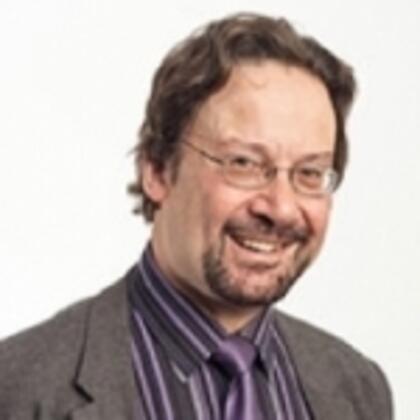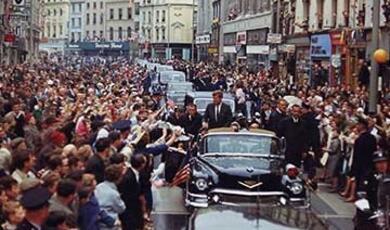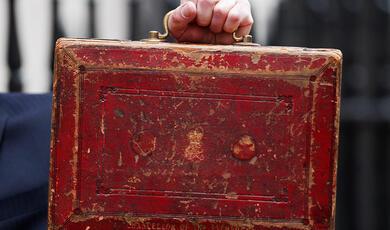Safety in the Nuclear Industry
Share
- Details
- Transcript
- Audio
- Downloads
- Extra Reading
Energy security and meeting the needs of both industry and consumers have become key topics for government. Major decisions will have to be taken by the next government over both de-commissioning and the re-commissioning of nuclear power stations. But how safe is safe? Can the experts re-assure us that modern advances in nuclear technology and its management can provide us with safe low-cost energy?
Download Transcript
22 June 2015
Safety in the Nuclear Industry
Professor Philip Thomas
Slide 1 - Safety in the Nuclear Industry
I thank Gresham College for this opportunity to talk to you today. I am very pleased to have the chance to give this lecture in the City of London. And it is particularly appropriate because some of the work I will present to you was carried out during my time at City University London, which is just up the road from here on Northampton Square. So my thanks go to City University for allowing me to work on the NREFS research project that I shall be quoting from later on.
Slide 2 - Nuclear power history
It is also appropriate for me to be speaking in the Museum of London, as nuclear power is, if not exactly antique, then well on its way to being vintage!
Man-made nuclear energy is nearly three quarters of a century old. The first reactor went critical on 2 December 1942. This was part of the Second World War Manhattan Project that led to the production of the atomic bomb. But the tiny amounts of energy that were produced in that first reactor were enough to demonstrate the principle of controlled nuclear fission. This allowed nuclear power to be harnessed from the mid-1950s onwards for the production of electricity.
Slide 3 - Nuclear power worldwide
To put safety in the nuclear industry into context, I am going to talk first about what the nuclear industry does and the range of tasks that it gets involved in. I shall start by talking about the generation of electricity and then talk about some of the other activities that are carried out in support of that main purpose.
Nuclear power now supplies an eighth of the world’s electricity. There are 435 nuclear power plants in operation worldwide, with 72 new stations under construction.
Pressurized Water Reactors, called PWRs because the nuclear industry loves acronyms, and Boiling Water Reactors or BWRs are the world's "workhorse" reactors. PWRs were used first to power nuclear submarines but then they were developed for onshore use to provide electricity for businesses and homes. Both PWRs and BWRs originated in the United States, although they are now designed and built by others also, such as France, Japan and China. Russia has its own variant of the PWR called the VVER – yet another acronym!
Slide 4 - The start of nuclear generation in the UK
The UK was the first to connect a nuclear power station to its national grid in 1956.
Calder Hall's reactors were Magnox reactors and Magnox reactors have supplied electricity to the UK grid for about 60 years now. The last one operating is due to close this year.
Slide 5 - Nuclear power in the UK today
Advanced Gas Reactors or AGRs have gradually taken over from the original, Magnox reactors. Seven twin AGR power stations were built between the mid-1960s and the late 1980s and they are still operating today.
Sizewell B is the UK's first and so far only PWR. It has been running for about 20 years.
Nuclear used to make up 30% of the UK's electricity at its peak. But nuclear's share has now fallen to 20% as a result of the older Magnox stations being taken out of service. By next year the UK's nuclear fleet will consist of just the seven twin-reactor AGRs and the one PWR, all owned and operated by EDF Energy.
Slide 6 - UK nuclear power in the future
EDF intends to build two more PWRs at Hinkley Point in Somerset and two further PWRs at Sizewell in Norfolk. Each of these will generate 1,670 megawatts of electricity. Meanwhile Horizon, which is a consortium between Hitachi of Japan and General Electric of the USA, wants to build four BWRs, at Wylfa in Anglesey and Oldbury in Gloucestershire. Each of these will produce 1,380 megawatts of electricity.
NuGeneration, which is a joint-venture between Toshiba of Japan and ENGIE of France (previously known as GDF Suez) wants to build three PWRs at Moorside in Cumbria, each of which will supply 1,135 megawatts of electricity into the National Grid.
This means that the total new nuclear capacity planned is 16 GW of electricity. With a big power station taken to produce about 1 GW or one thousand megawatts of electricity, this is equivalent to about 16 large, modern power stations.
Slide 7 - (Pictures)
The first PWR picture shows, in the foreground, the Areva Evolutionary Pressurised Water Reactor or EPR at Olkiluoto in Finland. Four of this type are planned for the UK.
The BWR shown is the Hitachi-GE Advanced Boiling Water Reactor or ABWR at Ohma in Japan. Four of these are planned for the UK
The last PWR picture is of the Westinghouse AP1000, standing for "Advanced PWR with an output of about 1,000 megawatts". Three of these are planned for the UK.
How far these live up to the style requirements of our new Energy Secretary, Amber Rudd, I shall leave to you to decide! But they are fairly compact industrial plants, and they stay pretty clean throughout their lives.
Slide 8 - Production of reactor fuel
The production of the fuel for the reactor starts with purified uranium ore or yellowcake. This is heated and treated first with hydrogen fluoride and then with fluorine gas to form gaseous uranium hexafluoride or "hex". The hex goes into a centrifuge enrichment plant to increase its fissile component, that is to say the uranium-235 isotope, to between 3% and 5%, depending on the destination reactor.
The outlet stream of hex is then exposed to steam and hydrogen to give uranium dioxide, which is a ceramic powder.
This powder is then pressed into pellets, which are typically 1 cm in diameter and 1 cm long. These fuel pellets are loaded into stainless steel or zircalloy cans – these are the fuel pins.
Slide 9 - Recycling in the nuclear industry: reprocessing
Spent fuel contains significant amounts of unused fissile material: uranium and newly made plutonium. Both of these elements can be used in power production and so they are both valuable.
In fact, the UK invested heavily in reprocessing up to about the year 2000. The ultimate goal was to recycle the plutonium in a fast reactor.
The fast reactor can convert low-grade uranium into useful plutonium at the same time as producing the heat needed to generate electricity. This has the big advantage that it would make the world's uranium stocks last 50 times longer.
The technology has been demonstrated, but unfortunately it is expensive. It is likely that recycling in this way will become commercially viable only when uranium stocks are starting to run low.
Slide 10 - Decommissioning
The UK started decommissioning of its shut-down, industrial-scale nuclear reactors in the 1980s. (Smaller, experimental nuclear reactors had been decommissioned before this.)
99% of the reactor's radioactivity is removed when the spent fuel is taken out of the reactor. Further dismantling can put the reactor in a safe state for long-term storage prior to final decommissioning.
I have a particular interest in the UK's first major reactor decommissioning project, as I was Customer Project Manager for the Windscale AGR or WAGR in the 1980s. I was also in charge of the necessary decommissioning research – robotics, remote viewing, remote cutting and so on. WAGR produced 100 MW of heat and 33MW of electricity until it was finally shut down after 18 years' operation in 1981.
I am happy to say that WAGR's core has now been dismantled and the reactor pressure vessel has been cut up and put into concrete filled WAGR Boxes. These are stored within a purpose-built Waste Package Building on the Windscale site.
Slide 11 - Decommissioning
The ultimate ambition for decommissioning is a green-field or brown-field site. Just this has happened with the spent fuel examination facilities at the UK Atomic Energy Authority's site at Culcheth near Warrington in Cheshire. You can see the "before" and "after" pictures.
Slide 12 - Radioactive waste: high level
The fission products produced by the nuclear reaction become the waste products. This high-level waste is vitrified and the glass blocks are then stored at Sellafield in Cumbria. The fission products decay and continue to produce heat for decades as they do so, and this heat has to be removed by forced air cooling.
But the amounts of high-level waste produced are very small.
To give you a picture, the vitrified volume of all the high-level waste produced in the UK for the last 65 years would fill the first 5 lanes of an Olympic running track to a height of 1 metre.
The small volume and the fact that it is all contained (unlike the carbon dioxide from fossil fuels) led John Ritch (formerly Director-General of the World Nuclear Association) to describe nuclear waste as a strong selling proposition for nuclear power:
"waste is nuclear power’s greatest comparative asset – precisely because the volume is minimal and can be safely managed without harm to people or the environment."
Slide 13 - Radioactive waste: intermediate and low level
Intermediate level waste is activated metal or material contaminated with the products of fission. Packaged intermediate level waste is stored on the Sellafield site. It doesn't require cooling.
Low level waste consists of lightly contaminated material such as used overshoes and some medical wastes. Packaged and grouted low level waste is placed in concrete vaults at Drigg in Cumbria.
Slide 14 - What are the safety hazards unique to nuclear?
So what are the safety hazards of nuclear power?
It is important to say at the outset that the laws of physics rule out an atomic-bomb-type explosion. This did not happen even at Chernobyl. In fact, it can't happen because the nuclear fuel in the reactor is not concentrated enough. It is enriched to typically 5% in the fissile component, compared with the over 90% needed for weapons-grade uranium.
A nuclear power station is, of course, a large process plant, and will experience many of the same hazards that any large plant would be subject to.
But there is the unique hazard of nuclear radiation.
Slide 15 - Types of radiation and stopping distances
The nuclear industry produces four types of radiation: alpha particles, beta particles, gamma rays and neutrons.
The first two are stopped fairly easily, especially alpha particles. But gamma rays and neutrons are both highly penetrative, and thick lead or metres of concrete are needed to contain them.
This means that the reactor will be surrounded by typically three metres of reinforced concrete, which is known as the biological shield.
Slide 16 - Radiation damage
All four types of radiation can ionise biological tissue and this produces a small chance that a disrupted human cell will become cancerous. The chance is proportional to the amount of energy the radiation deposits. This is the radiation dose, and to understand nuclear safety you need some feel for radiation dose units.
What is a big dose of radiation and what is a small dose?
Slide 17 - Radiation dose units
One Joule of energy deposited into a kilogram of tissue gives a dose of one Sievert (Sv) if the radiation is beta or gamma. But alpha particles and neutrons cause ten times the harm for the same amount of energy deposited, and so in these cases the dose would be 10 Sievert.
But the Sievert is a rather big unit, and it is normal to work with milliSievert in practice, that is to say a thousandth of a Sievert.
Slide 18 - Radiation doses in the UK
The average UK citizen receives 2.7 mSv in radiation dose each year, and this is nothing to do with the nuclear industry. Most of this comes from background radiation and about a seventh comes from medical X-rays.
The upper limit for radiation workers in the UK is 20 mSv per year, but no UK worker got more than half that amount in 2003, for example. The average dose for UK radiation workers is less than 1 mSv in a year.
These are all low doses, but what happens if you get a very large dose?
Slide 19 - Radiation hazards – very high doses
A dose of 500 mSv or more will lead to radiation sickness. If the dose reaches about 4,000 mSv, a significant number of the exposed people will die within a few months, although about half will recover. But if the dose exceeds about 8,000 mSv, most exposed people will die in days, weeks or a few months.
In the criticality incident at Tokaimura in Japan in 1999 – they were manually mixing nuclear fuel in a highly non-standard way – one worker received 3,000 mSv, one received 8,000 mSv and one got a dose of 18,000 mSv from neutrons. The 2 people with the high doses (8,000 and 18,000 mSv) both died within 7 months.
Slide 20 - Low doses: data from Hiroshima and Nagasaki survivors
Coming back to low doses, the main information on radiation hazards comes from the Hiroshima and Nagasaki bombings of 1945. The health of 87,000 Japanese survivors of the atomic bombs was monitored between 1950 and 1997. The acute effects had passed, but was there an increased chance of solid cancers?
41,000 of the 87,000 had died by 1997, almost all from natural causes. Of the 41,000 who had died, just over a fifth, about 9,000, had died from naturally occurring cancer.
It may surprise you to learn that, out of the 41,000 deaths, just 440 were due to a radiation-induced cancer in the period 1950 to 1997.
We may conclude that radiation is a rather weak carcinogen.
Slide 21 - Radiation hazards - low doses
Data from atom bomb and medical doses imply that the chance of dying before your normal term as a result of a cancer brought on by a low-dose of radiation is 40 in a million per mSv of dose for a member of the public (where the public will span all ages).
It is 32 in a million per mSv of dose for a nuclear industry worker, who will be over 18.
These coefficients double if the one-off dose or the dose in a year is more than 100 mSv.
Slide 22 - Radiation doses after an accident
So what radiation doses are experienced after a nuclear accident?
Very high doses, thousands of milliSievert, are rare even after a big accident, and will usually affect only a few nuclear workers at most - just 3 workers, of whom 2 died at Tokaimura in 1999, for example. Meanwhile, after the world's worst nuclear accident at Chernobyl in 1986, there were 136 workers who received a dose of 1,000 mSv or more, and 30 of these died.
But the accident may impose low doses on the remaining workforce or the public. Hence about 100 workers received low doses at Tokaimura and 20 members of the public. 161 members of the public were evacuated on a temporary basis at Tokaimura.
335,000 members of the public were evacuated permanently or "relocated" after Chernobyl, and I shall come back to this.
Slide 23 - Protecting the public
The evidence shows that it is very unlikely that a member of the public will be given a high radiation dose after an accident – it did not happen even after Chernobyl. This means that the main safety focus is on protecting the public from possible low doses of radiation.
But how big is this risk?
Slide 24 - The safety risk of nuclear power
Previous studies have tended to concentrate on the high integrity of nuclear engineering and the elaborate protection systems that reduce the chances of a nuclear accident. In fact a modern nuclear reactor is expected to suffer a severe accident less than once in ten million years.
But my research team wanted to know what happens in the worst-case scenario? When a nuclear reactor goes badly, catastrophically wrong, as happened at Chernobyl and at Fukushima Daiichi?
This was the question behind the NREFS project.
Slide 25 - The NREFS Project: Management of Nuclear Risk Issues: Environmental, Financial and Safety
Four universities came together for the NREFS project for which I was "principal investigator":
City University London
Manchester University
The Open University and
Warwick University
Slide 26 - NREFS concentrated on objective methods, starting with the Judgement- or J-value
We concentrated on applying objective methods, not those that depended on people's subjective opinions.
The Judgement- or J-value allows the balance to be found from the gain in life expectancy that a safety measure brings about as against the cost of providing it. You are spending too much if J is bigger than 1.
You cannot say how long anyone is going to live, but life expectancy gives you a handle on it – life expectancy is the average time remaining for someone of that age and that gender.
Slide 27 - Converting radiation dose into loss of life expectancy
My team, now based at Bristol University, has extended Lord Marshall's method for calculating loss of life expectancy caused by low-level radiation exposure. It is assumed, slightly conservatively, that a radiation exposure can cause death from cancer between 10 and 40 years later.
This loss of life expectancy can then be fed into the J-value, which tells you if the cost of the safety measure is worth it.
Slide 28 - Focussing on life expectancy: some numbers to bear in mind
I am going to give you some figures for you to bear in mind for comparisons later on.
80 is the life expectancy at birth in the UK.
42 years is the population-average life expectancy in the UK – this is roughly how long a 40-year-old can expect to live.
3½ years is how much life a Londoner loses by moving to Manchester.
4½ months is how much life a Londoner loses from air pollution.
Slide 29 - Chernobyl NPP accident: summary
The accident on Chernobyl Unit 4 took place in the early hours of the 26th of April 1986, and it is the world's worst nuclear accident by a large margin. The reactor went super-prompt critical and there was a huge nuclear power excursion that lasted about 5 seconds – a short time but a million times too slow for it to be regarded as an explosion. The top of the reactor was forced off, there were fires and there was an unobstructed release of reactor core materials into the air for 10 days. Some of the core melted through the reactor pressure vessel into the basement below before cooling and solidifying – an event that had been dramatised 7 years before as the "China Syndrome". It is difficult to see how things could have been any worse.
There were 30 immediate deaths of power station workers.
116 thousand members of the public were relocated in 1986 and a further 220 thousand were relocated post 1990. Never to return
But were such drastic population movements necessary or sensible?
Slide 30 - Chernobyl: first relocation in 1986
The 116,000 evacuated from the 30-km zone by September 1986 gained about 7 months' life expectancy. This implies a J-value of 3. The evacuation was three times too expensive and so should not have been carried out.
The relocation of about 17,000 people would have been justified at J = 1, so the number of people actually evacuated was seven times too high.
Slide 31 - Chernobyl: second relocation in 1990
The map shows how the relocation zone was extended in 1990 from the area marked in red to the area marked in dark orange.
Slide 32 - Chernobyl: second relocation in 1990
The "State All-Union and Republican Programme" relocated 220,000 people at a cost of 42,000 roubles per person. But they gained just 3 weeks in life expectancy.
The J-value is 21, so the exercise was over 20 times too expensive. Not one of these 220,000 people should have been relocated
Slide 33 - Effect of Chernobyl's radiation on the public
In the event, the 116,000 first evacuees lost just 9.3 days of life expectancy due to the radiation dose they received. We in the UK experienced some increase in radiation dose. We lost about 3 hours.
But even if no-one had been evacuated and relocated after Chernobyl, the loss of life expectancy amongst the worst-affected 6,000 people in Ukraine would have been about 3½ years. You will remember that this is the life expectancy lost by the average Londoner going to live in Manchester.
The gain in life expectancy for the worst affected 2,000 people of the 220,000 relocated in the 2nd phase was 2 months. This is about half the life expectancy we lose in London from air pollution.
Objectively, we can see that the scale of the potential radiation threat to the public is small even after the worst nuclear accident.
Slide 34 - Fukushima Daiichi NPP accident: summary
The three damaged reactors at Fukushima Daiichi shut down as they were designed to when the earthquake struck on 11 March 2011, but they lost cooling when the power stations were flooded by the tsunami 45 minutes later. Cooling was eventually restored, but the failure to remove the decay heat before that happened meant that part of the core melted. Explosions from the chemically induced hydrogen destroyed the roof of the shield building so that radioactivity escaped into the air. This radioactivity was added to by the radiation issuing from the damaged spent fuel pond on a fourth reactor.
The radiation released was about a sixth of the Chernobyl release. There were no radiation deaths, but 160,000 people were evacuated. This compares with the 267,000 people displaced by the direct effects of the tsunami.
Importantly, there were 1,121 deaths in the first 3 years from the nuclear evacuation amongst residents of old-people's homes.
Slide 35 - Fukushima Daiichi: evacuation worse than radiation?
By assuming the excess deaths were in people over 70 years old, we can calculate an average loss of life expectancy of 27 days. But this is more than the 19 days that the radiation would have cost them if they had stayed put.
These first, outline calculations are being confirmed by in-depth studies carried out in Japan.
The evidence is pointing towards evacuation not being an entirely safe option – it may cause net health detriments as well as incurring high costs.
Slide 36 - Post-Chernobyl sheep restrictions in UK
So now let us look at how the UK Government reacted to Chernobyl.
The UK imposed restrictions after Chernobyl on the movement, sale and slaughter of sheep on 9,700 farms in North Wales, Cumbria, Scotland and Northern Ireland.
Slide 37 - Removing the sheep restrictions in 2012
By 2010 the number of restricted farms had fallen to 300 and the Food Standards Agency was asked whether the restrictions could be lifted altogether. The Agency calculated this was reasonable.
But the interesting question was: should the restrictions have been lifted earlier?
Slide 38
The Food Standards Agency took as their "representative person" someone who was actually eating a very great deal of sheep meat from the restricted farms. NREFS calculated that such a person would experience a radiation-induced loss of life expectancy of just one and a half hours.
The total number of such people must, in any case, be quite low because the amount of sheep meat that the 300 restricted farms could produce would obviously be limited. In fact, the maximum number of people able to consume the large quantities of restricted sheep meat involved turns out to be 2,150. These two thousand or so people are eating the lot. This leads to a J-value of 230, which is far too high to make sense. The countermeasures were costing over 200 times too much.
The UK sheep restrictions were such poor value for money by 2010 that it is clear that they should have been dropped much earlier. Keeping them in place for 26 years constituted an over-reaction to Chernobyl.
Slide 39 - Fukushima Daiichi: remedial measures: urban decontamination
This is not to say that there are not useful things that you can do after a big nuclear accident. 110,000 houses in Fukushima City were decontaminated and this led to a 7-fold dose reduction. The gain in life expectancy was 35 days, and the cost was modest. The J-value was 0.04, so urban decontamination was fully justified.
Slide 40 - Lessons to be learned from big nuclear accidents
The big lesson is how small the radiation damage is to the members of the public from even the worst nuclear reactor accidents. Most of the harm has come from what can now be seen to be unjustified fear and worry and from the social disruption and dislocation caused by the relocation of hundreds of thousands of people.
Slide 41 - So is all well with safety in the nuclear industry?
So is all well with safety in the nuclear industry?
In fact there is a problem with the metric the UK nuclear industry uses in deciding how much to spend on safety. Like most of the UK's industry, the nuclear business uses the Department for Transport's "value of a prevented fatality" or VPF as a benchmark for how much it should spend on safety. Here it is merely following the lead of the Office for Nuclear Regulation and the Health and Safety Executive.
Unfortunately the VPF emerges as an essentially arbitrary figure, and it is likely to be about 4 times too low.
For comparison, the UK Department for Transport sees a British life as worth about 1.8 million pounds.
But the US Department of Transportation sees the value of the life of a US citizen as worth about 6.1 million pounds, and thinks it could be as high as 8.6 million pounds. Rather more, you will see.
Slide 42 - The 2-injury chained method on which the VPF is based
The UK VPF is based on the opinions of 167 people given in 1997, as interpreted using the 2-injury chained method.
Common sense suggests that two measurements of the same quantity, the "value of a prevented injury" for the same injury should come out the same. But using the 2 –injury chained method, they turn out to be very different and barely correlated.
Slide 43 - Value of a Prevented Injury (same injury)
Note the degree of variation for the Value of a Prevented Injury for the same injury.
Measured one way it varies from £300 to £50,000 ( that's on the horizontal axis).
Measured another way, but still using the 2-injury chained method, it comes out as from £100 to £3,000,000 (this is on the vertical axis).
Are people really disagreeing with one another by so much?
In fact, is each person really disagreeing so much with him- or her-self?
The points that are scattered all over this graph should all lie pretty much on a rather short straight line. And that straight line should have a slope of 1, not 8.24.
It is clear that the method on which the UK VPF is based is falsified in the sense of the scientific philosopher, Sir Karl Popper.
Slide 44 - The 39 steps to the UK's official VPF: the Carthy study
The finally recommended VPF of £1M is conceded by the authors to be a "judgement call". But the judgement range is enormous. It covers two orders of magnitude: £120,000 to £33M.
With such a range, how much numerical guidance from the 2-injury chained method can be said to remain?
Slide 45
The Carthy study authors wrote recently:
“we consider that the Carthy et al. study has made a useful contribution ... by providing evidence which, when blended with judgement, helped consolidate the VPF”
But how good was the previous VPF that they seem happy, through applying their “judgement”, to “consolidate”?
Slide 46 - The previous VPF – Dalvi report, DoT, 1988
The previous VPF came from the Dalvi report. Dalvi considered an earlier opinion survey, from 1985, then rejected the mean in favour of the median. This reduced the amount to be spent on safety considerably. Then he lowered it still further on apparently political grounds:
“It is felt that considering the Government’s present concern for speedy traffic movement, a value of £890,000 per statistical life saved is certainly on a higher side. This paper therefore suggests a lower figure of £500,000”
It is the latter, lower figure, adjusted for increases in GDP, that the Carthy study apparently “consolidated”.
Slide 47 - Can the nuclear industry do better?
So can the nuclear industry do better?
The answer must be "Yes".
It can replace the rather crude measure of a single-valued VPF of dubious provenance with the more sophisticated J-value, which is an objective measure based on the economic and actuarial data that the Office of National Statistics gathers each year based on the behaviour of millions of UK citizens.
Importantly the J-value has been validated against data for 180 out of the 193 countries in the United Nations.
Slide 48 - Protecting the environment
The J-value has been extended to take environmental consequences into account. The JT-value or Total Judgement value gives objective guidance on what should be spent to safeguard both humans and the environment.
The method is developed and the nuclear industry can use it today.
Slide 49 - Conclusions
Coming to conclusions, it is clear that the nuclear industry is now firmly established world-wide as a provider of electrical power to industry and homes.
On safety, the stand-out message from the NREFS project is that nuclear power is a lot less scary than many fear even when it goes badly wrong.
That said, it must be time to adopt properly scientific methods to guide the nuclear industry’s spending decisions on safety in the UK.
Thank you.
© Professor Philip Thomas, 2015
This event was on Mon, 22 Jun 2015
Support Gresham
Gresham College has offered an outstanding education to the public free of charge for over 400 years. Today, Gresham plays an important role in fostering a love of learning and a greater understanding of ourselves and the world around us. Your donation will help to widen our reach and to broaden our audience, allowing more people to benefit from a high-quality education from some of the brightest minds.


 Login
Login







